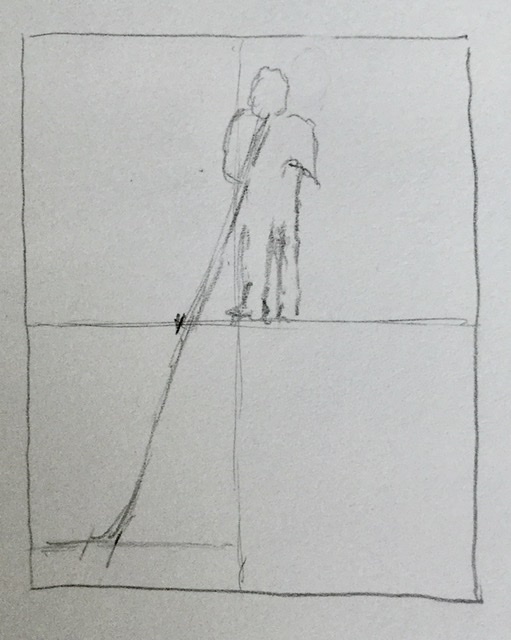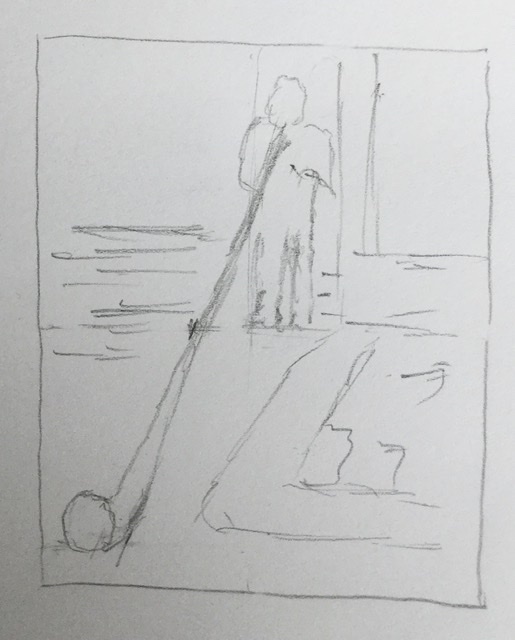Some of the scenes before us are more challenging to capture than others; we sketch then we are frustrated. Usually it is because we fail to follow the tried and true steps that have brought us success in the past. Shirley sent me a photo of such a scene. I am going to break down the process step by step, most of which should be used for any sketches we attempt.
Here is the photo

It is the horn that captures our initial attention. An easy error with this is to end up with the man too big and the horn too short and too fat. Our brain starts defining and gets it wrong.
The first step in any sketch is to ask, “What is it that makes this worth sketching?” “What is the focal point?” “What is the moment?”
Then, as we should always do, but often don’t, some analysis before we start. One important thing is to have a reference in the scene for size.

The man’s height is a good reference point. I measured his height from his shoulders to his feet; then all other measurements will be based on that length. The first thing I noticed was that the distance from his shoulders to the end of the horn is almost exactly 2x his height. This will help when we lay out the sketch.
Next I found that the length of the horn, from his hands/mouth is also 2x his height, the same length we just measured.

What we then need is a way to reference these when we sketch. In my workshops I talk about drawing a box and or drawing a cross on the page. I usually start by visualizing this on the scene in front of me. If you are sketching from a photo, print it out and actually draw the guidelines. Remember a lot of the classical artists used this kind of tool for reference, if it is OK for Van Gogh to do it, then it is good enough for me.

I purposely used the left edge of the man, then drew the horizontal line across at his feet. Doing this on the drawing will make the sketch work much better. Now you can get out your sketchpad. Start by either drawing a box or a cross, or both.

With the cross in place I sketched the man, keep it loose at this stage as we are trying to get sizes and proportions correct, not the final draft. I also realize that my first tendency might be to start by drawing the horn, which would most likely not work out well, remember we are using the man as the reference point. Also, even though the horn is the key item in the sketch, we have more leeway as far as length and shape than with the man; if the horn is a bit off no one will know.
Since I drew, or visualized, the cross before I started, it was pretty easy to get the rough shape of the man right. The next thing is to get the angle of the horn laid out. Using a pencil, or ruler I measured the angle by laying it on the photo. Transferring that angle to the sketch I made a small mark on the horizontal axis where the lower edge of the horn will cross the line, starting from the mans mouth.
What was left was to measure down vertically 2x the height of the man and make a mark to show the length of the horn. With this layed out sketching in the lower edge of the horn was easy.

Next came the opening in the bell of the horn. My brain, and thus my initial attempt, made the circle about the same size as the mans head, too small. In reality the circle is almost the same size as the width of the mans chest. What is going on here is that our brain knows the horn’s bell is probably no bigger than the man’s head, so it tells our pencil to draw it like that. But, objects that are closer to us “appear” bigger, this is called foreshortening, a topic for another day. Once again we remind ourselves to draw what we see, not what we think we see.

We have the basic sketch done, but it looks a little strange, a man and horn floating in the air. We need to add a bit of background and foreground detail to give context. Erase a few reference lines, though often leaving them ads character.

Maybe a bit of watercolor, some shading, highlights with ink and a gel pen, and you have your sketch.
One other consideration would be to move the men and their horns back into the distance. It would make them part of a bigger scene, and possible capture the place easier.

Let me know if there are more questions. Better yet, give the sketch a try yourself and send it to me.
Keep sketching,
This will be incredibly helpful; clear and detailed. Thank you. I’ll get to work on it now…..!
Shirley
LikeLike